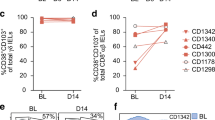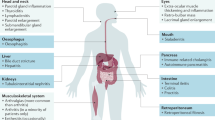Abstract
In this multicentre study, we examined 60 cases of Type II enteropathy-associated T-cell lymphoma (EATL) from the Asia-Pacific region by histological review, immunohistochemistry and molecular techniques. Patients were mostly adult males (median age: 58 years, male:female 2.6:1), presenting with abdominal pain (60%), intestinal perforation (40%) and weight loss (28%). None had a history of coeliac disease and the median survival was only 7 months. Histologically, these tumours could be divided into (i) central tumour zone comprising a monotonous population of neoplastic lymphocytes, (ii) peripheral zone featuring stunted villi and morphologically atypical lymphocytes showing epitheliotropism, and (iii) distant mucosa with normal villous architecture and cytologically normal intra-epithelial lymphocytes (IELs). Characterized by extensive nuclear expression of Megakaryocyte-associated tyrosine kinase (MATK) (87%) and usually a CD8+CD56+ (88%) cytotoxic phenotype, there was frequent aberrant expression of CD20 (24%). T-cell receptor (TCR) expression was silent or not evaluable in 40% but of the remainder, there was predominant expression of TCRαβ over TCRγδ (1.6:1). In keeping with the normal ratio of IEL subsets, CD8+ cases showed predominant CD8αα homodimer expression (77%), regardless of TCR lineage. These tumours constitute a distinct entity from classical EATL, and the pathology may reflect tumour progression from IEL precursors, remnants of which are often seen in the distant mucosa.
This is a preview of subscription content, access via your institution
Access options
Subscribe to this journal
Receive 12 print issues and online access
$259.00 per year
only $21.58 per issue
Buy this article
- Purchase on Springer Link
- Instant access to full article PDF
Prices may be subject to local taxes which are calculated during checkout





Similar content being viewed by others
References
Delabie J, Holte H, Vose JM, Ullrich F, Jaffe ES, Savage KJ et al. Enteropathy-associated T-cell lymphoma: clinical and histological findings from the international peripheral T-cell lymphoma project. Blood 2011; 118: 148–155.
Isaacson PGCA, Ott G, Stein H . Enteropathy-associated T-cell lymphoma. In: Swerdlow SHCE, Harris NL, Jaffe ES, Pileri SA, Stein H, Thiele J, Vardiman JW, (eds). WHO Classification of Tumours of Haematopoietic and Lymphoid Tissues 4th edn. IARC: Lyon, France, 2008; pp 289–291.
Chan JK, Chan AC, Cheuk W, Wan SK, Lee WK, Lui YH et al. Type II enteropathy-associated T-cell lymphoma: a distinct aggressive lymphoma with frequent gammadelta T-cell receptor expression. Am J Surg Pathol 2011; 35: 1557–1569.
Sun J, Lu Z, Yang D, Chen J . Primary intestinal T-cell and NK-cell lymphomas: a clinicopathological and molecular study from China focused on type II enteropathy-associated T-cell lymphoma and primary intestinal NK-cell lymphoma. Mod Pathol 2011; 24: 983–992.
Lan Q, Shen M, Garcia-Rossi D, Chanock S, Zheng T, Berndt SI et al. Genotype frequency and F ST analysis of polymorphisms in immunoregulatory genes in Chinese and Caucasian populations. Immunogenetics 2007; 59: 839–852.
Lee KW, Oh DH, Lee C, Yang SY . Allelic and haplotypic diversity of HLA-A, -B, -C, -DRB1, and -DQB1 genes in the Korean population. Tissue Antigens 2005; 65: 437–447.
Liang CK, Chen KH, Hsu WM . Association of HLA type and Mooren’s Ulcer in Chinese in Taiwan. Br J Ophthalmol 2003; 87: 797–798.
Saito S, Ota S, Yamada E, Inoko H, Ota M . Allele frequencies and haplotypic associations defined by allelic DNA typing at HLA class I and class II loci in the Japanese population. Tissue Antigens 2000; 56: 522–529.
Shaw CK, Chen LL, Lee A, Lee TD . Distribution of HLA gene and haplotype frequencies in Taiwan: a comparative study among Min-nan, Hakka, Aborigines and Mainland Chinese. Tissue Antigens 1999; 53: 51–64.
Chim CS, Au WY, Shek TW, Ho J, Choy C, Ma SK et al. Primary CD56 positive lymphomas of the gastrointestinal tract. Cancer 2001; 91: 525–533.
Chuang SS, Chang ST, Chuang WY, Huang WT, Hsieh PP, Tsou MH et al. NK-cell lineage predicts poor survival in primary intestinal NK-cell and T-cell lymphomas. Am J Surg Pathol 2009; 33: 1230–1240.
Ko YH, Karnan S, Kim KM, Park CK, Kang ES, Kim YH et al. Enteropathy-associated T-cell lymphoma--a clinicopathologic and array comparative genomic hybridization study. Hum Pathol 2010; 41: 1231–1237.
Ogawa A, Fukushima N, Satoh T, Kishikawa M, Miyazaki K, Tokunaga O . Primary intestinal T-cell lymphoma resembling lymphomatous polyposis: report of a case. Virchows Arch 2000; 437: 450–453.
Tung CL, Hsieh PP, Chang JH, Chen RS, Chen YJ, Wang JS . Intestinal T-cell and natural killer-cell lymphomas in Taiwan with special emphasis on 2 distinct cellular types: natural killer-like cytotoxic T cell and true natural killer cell. Hum Pathol 2008; 39: 1018–1025.
Chott A, Haedicke W, Mosberger I, Fodinger M, Winkler K, Mannhalter C et al. Most CD56+ intestinal lymphomas are CD8+CD5-T-cell lymphomas of monomorphic small to medium size histology. Am J Pathol 1998; 153: 1483–1490.
Takeshita M, Nakamura S, Kikuma K, Nakayama Y, Nimura S, Yao T et al. Pathological and immunohistological findings and genetic aberrations of intestinal enteropathy-associated T cell lymphoma in Japan. Histopathology 2011; 58: 395–407.
Chuang SS, Liao YL, Liu H, Lin SH, Hsieh PP, Huang WT et al. The phenotype of intraepithelial lymphocytes in Taiwanese enteropathy-associated T-cell lymphoma is distinct from that of the West. Histopathology 2008; 53: 234–236.
Tan SY, Ooi AS, Ang MK, Koh M, Wong JC, Dykema K et al. Nuclear expression of MATK is a novel marker of type II enteropathy-associated T-cell lymphoma. Leukemia 25: 555–557.
Ravikumara M, Nootigattu VK, Sandhu BK . Ninety percent of celiac disease is being missed. J Pediatr Gastroenterol Nutr 2007; 45: 497–499.
DAKO. Histology FISH Accessory Kit. 2010 [cited 15 May 2012]; Working Procedure]. Available from http://www.dako.com/dist/ar42/p234660/prod_products.htm.
McCarthy KP, Sloane JP, Kabarowski JH, Matutes E, Wiedemann LM . A simplified method of detection of clonal rearrangements of the T-cell receptor-gamma chain gene. Diagn Mol Pathol 1992; 1: 173–179.
Akiyama T, Okino T, Konishi H, Wani Y, Notohara K, Tsukayama C et al. CD8+, CD56+ (natural killer-like) T-cell lymphoma involving the small intestine with no evidence of enteropathy: clinicopathology and molecular study of five Japanese patients. Pathol Int 2008; 58: 626–634.
Hayday A, Theodoridis E, Ramsburg E, Shires J . Intraepithelial lymphocytes: exploring the third way in immunology. Nat Immunol 2001; 2: 997–1003.
van Wijk F, Cheroutre H . Intestinal T cells: facing the mucosal immune dilemma with synergy and diversity. Semin Immunol 2009; 21: 130–138.
Roitt IM, Delves. PJ . The anatomy of the immune response. In: Roitt’s Essential Immunology 10th edn. Blackwell Science: London, UK, 2001; pp 155–157.
Vose J, Armitage J, Weisenburger D . International peripheral T-cell and natural killer/T-cell lymphoma study: pathology findings and clinical outcomes. J Clin Oncol 2008; 26: 4124–4130.
Bagdi E, Diss TC, Munson P, Isaacson PG . Mucosal intra-epithelial lymphocytes in enteropathy-associated T-cell lymphoma, ulcerative jejunitis, and refractory celiac disease constitute a neoplastic population. Blood 1999; 94: 260–264.
Carreras JK, Goldschmidt M, Lamb M, McLear RC, Drobatz KJ, Sørenmo KU . Feline epitheliotropic intestinal malignant lymphoma: 10 cases (1997–2000). J Vet Intern Med 2003; 17: 326–331.
Pinkerton ME, Bailey KL, Thomas KK, Goetz TE, Valli VE . Primary epitheliotropic intestinal T-cell lymphoma in a horse. J Vet Diagn Invest 2002; 14: 150–152.
Sanz MG, Sellon DC, Potter KA . Primary epitheliotropic intestinal T-cell lymphoma as a cause of diarrhoea in a horse. Can Vet J 2010; 51: 522–524.
Acknowledgements
This study was funded by the Programme Project Grant and the CISSP programme (2010/022) from the National Medical Research Council of Singapore, the Singhealth Foundation Project Grant (SHF/FG438P/2010), HSBC Trustee (Singapore) Limited as trustees of the Major John Long Trust Fund and the Chew Woon Poh Trust Fund.
Author information
Authors and Affiliations
Corresponding author
Ethics declarations
Competing interests
The authors declare no conflict of interest.
Additional information
Author Contributions
SYT, LT and STL designed research, performed research, contributed bioresources and data, analysed data and wrote the paper. SSC, TT, YHK, KLC, SBN, WJC, KG, FL, PH, YHL, PLC, BTT, KT and MK performed research, contributed bioresources and research data and analysed data.
Supplementary Information accompanies this paper on the Leukemia website
Supplementary information
Rights and permissions
About this article
Cite this article
Tan, SY., Chuang, SS., Tang, T. et al. Type II EATL (epitheliotropic intestinal T-cell lymphoma): a neoplasm of intra-epithelial T-cells with predominant CD8αα phenotype. Leukemia 27, 1688–1696 (2013). https://doi.org/10.1038/leu.2013.41
Received:
Revised:
Accepted:
Published:
Issue Date:
DOI: https://doi.org/10.1038/leu.2013.41
Keywords
This article is cited by
-
PEG-Asparaginase Single-Agent Rescue in an Advanced Case of Monomorphic Epitheliotropic Intestinal T Cell Lymphoma
Journal of Gastrointestinal Cancer (2023)
-
Extranodal T- and NK-cell lymphomas
Virchows Archiv (2023)
-
CD30 + Primary intestinal T-cell lymphoma (unclassified) masquerading as chronic inflammation: a case report
Diagnostic Pathology (2022)
-
Genetic profiling and biomarkers in peripheral T-cell lymphomas: current role in the diagnostic work-up
Modern Pathology (2022)
-
Successful early diagnosis of monomorphic epitheliotropic intestinal T-cell lymphoma manifesting as chronic diarrhea and hypokalemia using video capsule endoscopy and double-balloon enteroscopy
Clinical Journal of Gastroenterology (2022)



